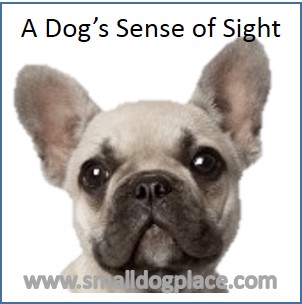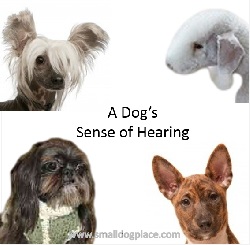- Small Dog Place Home
- Dog Senses
Dog Senses
Surprising Facts on A Dog's World View
by Janice Jones |Last Updated 12-06-2023
Dog Senses are the same as people in that we both share the ability to see, hear, smell, taste, and touch.
Beyond that, we live in very different worlds when it comes to the senses. Dogs share our homes, our lives and often our pillows, but we perceive the world is different from what the dog experiences.
Understanding what our dogs are experiencing can help us understand them better and lead to deeper bonds, improved behaviors, and successful training sessions.
The Five Dog Senses
Sight
As humans, we live in a visual world, perceiving tens of millions of colors which allows us to enjoy the rich colors of spring and warm tones of autumn.
We probably receive about 9 million bits of information coming in through our eyes every second. Our ability to see like this takes up a large part of our brains. Without stopping to think, we may assume that our dogs are seeing exactly what we see, which is not the case.
It is time to reconsider the old stereotypes of people living in a visual world and a dog in an auditory/olfactory realm. Science is proving this wrong. What is known though, is that dogs and humans see things a little differently. Dogs can see better at night due to some unusual anatomical differences. Can they see neon lights?
We can't generalize about vision in dogs without taking into consideration breed differences.
Read more about the dog’s vision
Hearing
Our sense of hearing, while adequate for our needs is not nearly as refined as the dog. If given a letter grade for our sense of smell, we would not fare well, either. We would end up with a C- or D+ at best, with our little dog outshining us with his usual A+.
As humans, we can hear frequencies up to about 20,000 hertz, but our little dogs can detect sounds upwards of 45,000 to 67,000 Hertz giving them an edge on hearing the high pitched sounds of small prey.
Read more about the dog’s sense of hearing
Smell
Of all the dog senses, smell is the most important one to the dog. The part of our brains that deals with odors is significantly reduced, compared to the dog and we have far fewer odor receptors making it difficult for people to understand the subtleties that dogs can experience.
Most people are just fine with this “impairment” because we would likely turn our noses up on many of the odors that dogs fine irresistible.
This is a big difference between how we use our sense of smell and that of our small dogs. We experience the world primarily through our eyes and our ears. Our dogs rely on their noses to make sense of their world.
Read more about the dog’s sense of smell
Taste
Taste is an incredibly important sense for humans. While the appearance and aroma of our favorite dish is important, we would probably leave it sitting on the plate if the food didn’t taste good.
Dogs can gulp down a meal in less than a minute, barely tasting the food. The difference lies in the number of taste buds we possess.
Humans have a whopping 9000 to a dog’s measly 1700 giving us the upper hand when it comes to taste. If smell is the most important of the dog senses, then taste is the least significant.
Just as young babies and toddlers explore their world with their tongue, puppies do the same thing. You might even be surprised to learn that puppies and older dogs will lick you because they think you taste good.
Read more about the dog’s sense of taste
Touch
Touch is important to both you and your dog. Of all the senses, touch is perhaps the most similar in humans and dogs. A dog’s sense of touch is one of only a couple of senses present at birth, which also includes smell and taste.
Our mutual need to touch and be touched may be one reason why the bond between humans and dogs become so strong.
Read more about a dog’s sense of touch
About Janice (author and voice behind this site)
Having lived with dogs and cats most of her life, Janice served as a veterinary technician for ten years in Maryland and twelve years as a Shih Tzu dog breeder in Ohio.
Her education includes undergraduate degrees in Psychology with a minor in biology, Early Childhood Education, and Nursing, and a master's in Mental Health Counseling.
She is a lifelong learner, a dog lover, and passionate about the welfare of animals. Her favorite breed for over 50 years has been the Shih Tzu, but she has also lived with Poodles, Maltese, Yorkshire Terriers, Beagles, English Bulldogs, Carin Terriers, and a Cocker Spaniel.
When not writing, reading, and researching dog-related topics, she likes to spend time with her eight Shih Tzu dogs, husband, and family, as well as knitting and crocheting. She is also the voice behind Miracle Shih Tzu and Smart-Knit-Crocheting
Does This Article Deserve Your Thumbs Up?
We always appreciate your support and encouragement. Your thumbs up means so much to us. Please like this article.
If you find this page or any page on Small Dog Place Helpful, or useful in anyway, I'd love it if you would click the small heart found on the bottom right of each page.
You can also share or bookmark this page -- just click on the:

Free Monthly Newsletter
Sign Up for Our Free Newsletter and get our Free Gift to You.
my E-book, The Top 10 Mistakes People Make When Choosing a Dog (and how to avoid them)






